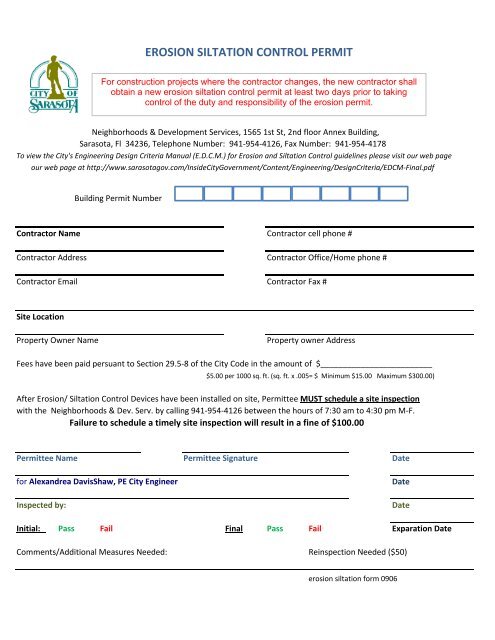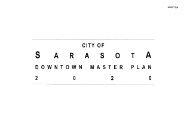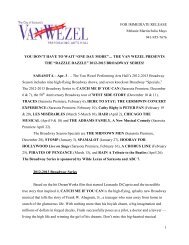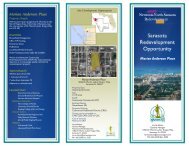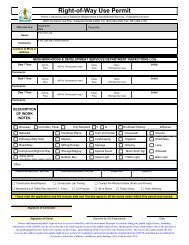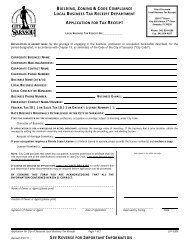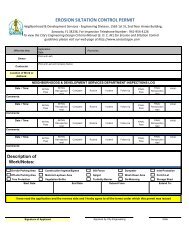EROSION SILTATION CONTROL PERMIT - City of Sarasota
EROSION SILTATION CONTROL PERMIT - City of Sarasota
EROSION SILTATION CONTROL PERMIT - City of Sarasota
Create successful ePaper yourself
Turn your PDF publications into a flip-book with our unique Google optimized e-Paper software.
<strong>EROSION</strong> <strong>SILTATION</strong> <strong>CONTROL</strong> <strong>PERMIT</strong><br />
For construction projects where the contractor changes, the new contractor shall<br />
obtain a new erosion siltation control permit at least two days prior to taking<br />
control <strong>of</strong> the duty and responsibility <strong>of</strong> the erosion permit.<br />
Neighborhoods & Development Services, 1565 1st St, 2nd floor Annex Building,<br />
<strong>Sarasota</strong>, Fl 34236, Telephone Number: 941-954-4126, Fax Number: 941-954-4178<br />
To view the <strong>City</strong>'s Engineering Design Criteria Manual (E.D.C.M.) for Erosion and Siltation Control guidelines please visit our web page<br />
our web page at http://www.sarasotagov.com/Inside<strong>City</strong>Government/Content/Engineering/DesignCriteria/EDCM-Final.pdf<br />
Building Permit Number<br />
Contractor Name Contractor cell phone #<br />
Contractor Address Contractor Office/Home phone #<br />
Contractor Email<br />
Contractor Fax #<br />
Site Location<br />
Property Owner Name<br />
Property owner Address<br />
Fees have been paid persuant to Section 29.5-8 <strong>of</strong> the <strong>City</strong> Code in the amount <strong>of</strong> $_________________________<br />
$5.00 per 1000 sq. ft. (sq. ft. x .005= $ Minimum $15.00 Maximum $300.00)<br />
After Erosion/ Siltation Control Devices have been installed on site, Permittee MUST schedule a site inspection<br />
with the Neighborhoods & Dev. Serv. by calling 941-954-4126 between the hours <strong>of</strong> 7:30 am to 4:30 pm M-F.<br />
Failure to schedule a timely site inspection will result in a fine <strong>of</strong> $100.00<br />
Permittee Name<br />
Permittee Signature<br />
Date<br />
for Alexandrea DavisShaw, PE <strong>City</strong> Engineer<br />
Date<br />
Inspected by:<br />
Date<br />
Initial: Pass Fail Final Pass Fail Exparation Date<br />
Comments/Additional Measures Needed: Reinspection Needed ($50)<br />
erosion siltation form 0906
No disturbed area may be denuded for more than thirty (30) calendar days unless otherwise authorized by the <strong>City</strong> Engineer. Denuded areas must be<br />
covered by mulches such as straw, hay, filter fabric, seed and mulch, sod, or some other permanent vegetation.<br />
Within sixty (60) calendar days after final grade is established on any portion <strong>of</strong> a project site, that portion <strong>of</strong> the site shall be provided with established<br />
permanent soil stabilization measures according to the original construction plan, whether by impervious surface or landscaping.<br />
Soil stockpiles shall be protected at all times by on‐site drainage controls which prevent erosion <strong>of</strong> the stockpiled material. Control <strong>of</strong> dust<br />
from such stockpiles may be required depending upon their location and the expected length <strong>of</strong> time the stockpiles will be present. In no case<br />
shall no unstabilized stockpile remain in place longer than thirty (30) calendar days.<br />
During construction, all storm sewer inlets receiving drainage from the project shall be protected by sediment traps such as, but not<br />
necessarily limited to, secured filter socks, sod, or stone which shall be maintained and modified as required by construction progress, and<br />
which shall be approved by the <strong>City</strong> Engineer before installation. In no case shall sediment or debris be allowed to enter a public<br />
right‐<strong>of</strong>‐way in such a manner as to create a traffic hazard, a public nuisance, or a threat to existing drainage ways.<br />
Sediment basins and traps, perimeter berms, filter fences, berms, sediment barriers, vegetative buffers and other measures intended to trap<br />
silt or prevent the transport <strong>of</strong> silt onto adjacent properties, or into storm sewer systems or existing water bodies, shall be installed,<br />
constructed, or, in the case <strong>of</strong> vegetative buffers, protected from disturbance, as a first step in the land alteration process. Such systems shall<br />
be fully operative and inspected by the <strong>City</strong> Engineer before any other disturbance <strong>of</strong> the site begins. Earthen structures, including but not<br />
limited to berms, earth filters, dams, or dikes, shall be stabilized and protected from drainage damage or erosion within one (1) week or<br />
installation.<br />
Areas <strong>of</strong> five (5) acres or more shall be required to have temporary sedimentation basins as a positive remedy against downstream siltation,<br />
which shall be shown and detailed on construction plans. During development, permanent retention areas may be used in place <strong>of</strong><br />
sedimentation basins provided they are maintained to the satisfaction <strong>of</strong> the <strong>City</strong> Engineer. The contractor shall prohibit the discharge <strong>of</strong> silt<br />
through the outfall structure during construction <strong>of</strong> any retention area and shall clean out the retention area before installing any permanent<br />
subdrain pipe. In addition, permanent retention areas shall be totally cleaned out and operating properly at the time <strong>of</strong> final inspection and at<br />
the end <strong>of</strong> any applicable warranty period. When temporary sedimentation basins are used, they shall be capable at all times <strong>of</strong> containing at<br />
least on one cubic foot (1 c.f.) <strong>of</strong> sediment for each one hundred square feet (100 s.f.) <strong>of</strong> area tributary to the basin. Such capacity shall be<br />
maintained throughout construction by regular removal <strong>of</strong> sediment from the basin.<br />
Land alteration and construction shall be minimized in all waterways and in a 25‐foot‐wide strip adjacent to the water, as measured from<br />
the top <strong>of</strong> the bank <strong>of</strong> the waterway. Construction equipment and motor vehicles shall be kept out <strong>of</strong> waterways and the 25‐foot buffer area<br />
whenever possible. Barriers shall be used to prevent access by construction equipment and motor vehicles. Where in‐channel work cannot be<br />
avoided, precautions shall be taken to stabilize the work area during land alteration, development, and construction to minimize erosion. If<br />
the channel or buffer area is disturbed during land alteration, it shall be stabilized within three (3) calendar days after the in‐channel work is<br />
completed. Silt curtains or other filter/siltation reduction devices shall be installed on the downstream side <strong>of</strong> the in‐channel activity to<br />
alleviate increased turbidity. Wherever stream crossings are required, properly‐sized temporary culverts shall be provided and shall be<br />
removed when construction is completed. Upon completion <strong>of</strong> construction, the area <strong>of</strong> the crossing shall be restored to a condition equal to<br />
or better than that which existed prior to the construction activity.<br />
All disturbed or constructed swales, ditches, and channels leading from the site shall be sodded within three (3) days <strong>of</strong> excavation. All<br />
interior swales and detention areas shall be sodded prior to issuance <strong>of</strong> a Certificate <strong>of</strong> Occupancy.<br />
The construction <strong>of</strong> all underground facilities shall be accomplished in an expeditious manner, with backfill and restoration lagging no more<br />
than four hundred feet (400 ft.) behind excavation and installation. Where appropriate, excavated material shall be cast onto the uphill side <strong>of</strong><br />
any trench and shall not be cast into any channel, channel bank, or gutter.<br />
All erosion control devices shall be inspected and documented every seven (7) days, and after each rainfall, and shall be cleaned or repaired<br />
as required.<br />
Maintenance <strong>of</strong> all soil erosion and siltation control practices, whether temporary or permanent, shall be at all times the responsibility <strong>of</strong> the<br />
permittee. Failure to do so can cause rescinding <strong>of</strong> ESC Permit, and/or payment to the <strong>City</strong> for cleaning <strong>of</strong> downstream facilities and areas.<br />
erosion siltation form 0906


